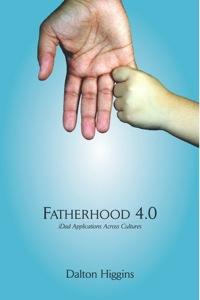Fatherhood 4.0: iDad Applications Across Cultures

From the outset, I was behind author Dalton Higgins’ endeavor in Fatherhood 4.0: iDad Applications Across Cultures. As an African-Canadian of Jamaican decent, Higgins writes to and for dads like him—multicultural, technologically and culturally current thirty-somethings figuring out how to parent in their contemporary Canadian society. And wouldn’t you know it, apparently he has quite the audience to speak to. Citing numerous Statistics Canada numbers, Higgins makes a case for Canada’s new generation of dads—racially and ethnically diverse, many being partners in mixed marriage couplings, and hardly any (just seventeen percent in 2006) mirroring the nuclear family image. He also notes an upswing in fathers taking advantage of the nationally available five weeks paternity leave, as well as an increase in stay-at-home dads. Alongside these paternal shifts, Higgins is hyper-aware of and interested in the role Internet, smartphones, and pop culture saturation has on influencing twenty-first century fatherhood.
But, this is not a self-help or how-to book. It is much more about voice and self-representation. Largely a patchwork of Higgins’ own writings on parenting within the black community, from hip-hop to absent fathers, as well as an incorporation of his interviews with Canadian public figures on their being fathers, Fatherhood 4.0 attempts a lot. Towards the book’s end, there are also quite a few essays on fatherhood trends within Canada’s indigenous population; a transgender man’s experience getting pregnant, and more musings on seeking (positive) representations of fathers of color in the media. However, despite a lot of the book’s promise, I found much to be desired.
As a writer, I felt that Higgins was too casual in language and analysis of his subject matter. Yes, I understand that he is a blogger, a pop culture/hip hop expert, and supportive of using contemporary slang and lingo to reach the younger generation of fathers he is targeting… but still. You can talk about Snoop Dogg and tweeting and fatherhood, and still do so at an authoritative and exploratory level. The splices of Higgins’ segments throughout repeated much of the same kitschy popular references, statistics, and general themes without ever developing any of them—at least to my satisfaction. And although Higgins interviews showcase stories from a diverse range of “media-savvy, multi-culti dads,” they all read rather stale. To be fair, I know very little about contemporary Canadian culture, and had to Google all of his interviewees, save for Broken Social Scene’s Charles Spearin. This, I am sure, considerably affected my lack of engagement with each man’s narrative. But, I also think that as an interviewer and framer, Higgins could have delved deeper. Although there were narrative similarities, I struggled to latch onto the unique aspects of each father’s circumstances in light of being a person of color, technologically inclined, or both.
My two favorite contributions were sandwiched at the book’s end—a segment written by Dr. Jessica Ball, entitled “Fathering in the Shadows: Indigenous Fathers and Canada’s Colonial Legacies” and excerpts from trans father Syrus Marcus Ware’s “Boldly Going Where Few Men Have Gone Before.” Although brief segments, I found myself most engaged here, as both not only presented fatherhood narratives foreign to me, but also followed through in their presentation as informative sources.
Overall, the book’s organization was off-putting, as I could never really understand Higgins’ intention. At one moment seemingly focused on various contemporary efforts to promote fatherhood within the black community, and another addressing technology and culture, this book lacks focus—and unfortunately, the multi-faceted narratives, and all that could be discussed, suffer from it.